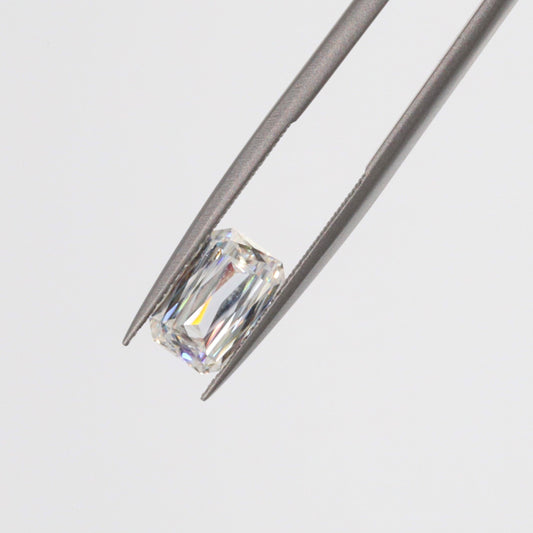Pavé, (pronounced pah-veh) is derived from french and means “pavement” ie cobblestone paved street. Skillfully set pavé bands in jewelry is exquisitely beautiful and espouses an unparalleled delicate appearance. There are a myriad of pave styles to choose from, many styles overlap and resemble one another while others create a drastically different look to a design.
Bead Bright Cut Pavé
Bead bright cut pavé bands are oftentimes called channel set pavé because the pavé stones are normally set between two metal walls that frame the stone an provide increased durability due to less stone being exposed.
Bright cut pavé begins with choosing the appropriate sized Moissanites for the band surface and dividing it evenly using a divider to mark the points where the melee will eventually be set. The metal that will eventually surround the melee is carefully carved with the help of a sharp graver, basically chiseling the metal into beads or prongs that hold down the melee. The beads are then shaped using a beading tool that shape the prongs into hemispherical balls. The final step involves the creating of the bright cut walls using the sharp graver tool. These walls are indented into the metal which creates the relief of the prongs holding the stones. The walls framing the beads are what actually give the name to this style of pavé. The name Bright cut refers to the walls that are cut with the graver tools creating highly polished walls that produces a very reflective surface. These bright-cut walls reflect light into the melee Moissanites.
There can be slight differences within the bright cut pavé style as well. One difference can be in the number of prongs or beads holding a single melee stone. Bright cut can be done using four beads or two beads per melee stone. The difference between four prong and two prong bright cut is subtle and might not be noticed unless a person was to inspect the pavé using magnification. The two bead version of bright cut pavé is exactly that, two beads holding a single stone located on two corners. The four bead version has four beads securing a stone located on the four corners of an individual melee stone. Each sub-style of bright-cut pavé can have minimal metal separating individual melee stones.


Bright cut pavé can additionally be done in rows or at angles from each other. This can be called multi row bright cut pavé . The most common form of multi-row bright cut pavé is seen on bands of ring that have three rows of pavé on them. The top most surface of the band is set with melee and the sides of the band at typically a perpendicular angle to the first is also set with Moissanite melee. The exact angles can be adjusted to taste. There is actually no limitation as to how many rows of pavé that can be done on a surface of metal as long as there is enough surface area. Other popular ring styles such as “knife edge” bands or shanks can be set with two rows of bright cut pavé that are at sharp angles the cut out of which would resemble the shape of an inverted V.
Contemporary Pavé Styles
Advancements in gem cutting and metal casting have allowed for extreme tolerances as small as 10 micrometers; which allows designers to minimize the amount of visible metal and still achieve a relatively durable ring.
What is French Pavé

French cut pavé refers to the way the small pavé Moissanites are set into the metal of the ring. The stone setter hand cuts small V shapes into the metal in order to set the Moissanites.
This style is meant to show as little metal as possible, making rings appear like they are solid Moissanites. There are numerous variants of French Pave such as Neo French Cut, U-cut, and Delicate French Cut all with their own slightly modified characteristics.
Shared Prong

Shared prong settings (technically not pavé) are typically used for melee stones that are larger. Because the melees are larger, they require more metal to hold them in place. However, it'd be pointless to have bigger melee stones if each stone had its own set of prongs holding it in place blocking most of the light from filtering through. In a shared prong setting, each stone shares one set of prongs with the stone next to it. With less visible metal, more light can pass through each Moissanite, which leads to added fire and brilliance.
Pavé styles come in uncountable variations and any band can be customized to your liking, as long as the durability of the band is sound. Visit our bespoke page at: https://gemaandco.com/pages/bespoke to design your own custom band!




